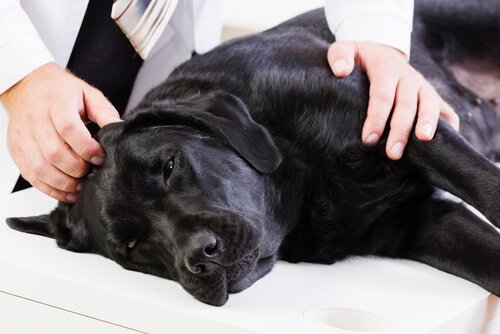What Do I Do If My Dog Gets Cancer?

The data is shocking: around half of dogs over the age of ten are at risk of cancer, which as we know, in humans is a very serious disease. In dogs, it can sometimes be detected by palpating the body to search for tumors.
Knowing the variables that increase the risk of your dog getting cancer, learning how to detect possible tumors, and learning about the symptoms: these are the first steps. This way you’ll be able to detect it early and get treatment if your dog is diagnosed with cancer.
Risk factors for cancer in dogs

Usually cancer originates in a single cell that undergoes genetic mutations. And while we don’t know for sure why this disease develops, there are some common risk factors we should be aware of:
- It’s uncommon for puppies or young dogs to develop tumors. Typically, cancer is found in middle-aged or older dogs.
- Not all breeds of dog are at the same risk of getting cancer. Some have a much greater risk, such as boxers, German shepherds, Scottish terriers and Golden retrievers.
- Female dogs usually have a higher propensity, specifically for breast cancer.
- Size can also be a determining factor. Some bone tumors are more frequent in dogs that weigh over 20 kilos, or large breed dogs.
- Genetic factors are also important. Some dogs are especially at risk for diseases like cancer simply due to their genetic make-up.
Taking action in time
Going to the vet frequently for check-ups and conducting tumor checks at home are two of the most important ways of catching cancer early. They will help you to identify suspicious growths or lumps that can mean cancer. If you discover such a lump at home, make sure to schedule a visit to the vet as soon as possible.
Doing a quick check of your dog every day is a very good way to detect abnormal lumps. You can take advantage of the time you spend brushing him or playing with him. Or do it when you’re bathing him or just petting him.
Simply apply pressure with your fingers in areas such as the groin, belly, abdomen and neck. That’s all it takes to find signs of anything out of the ordinary.
Signs that your dog is sick
- Abnormal lumps that don’t go away, or lumps that grow or change.
- Wounds or ulcers that take an unusually long time to heal.
- Long-term loss of appetite, weight loss, and difficulty eating and swallowing.
- Bleeding, wounds, limpness and stiffness in the legs.
- Difficulty breathing, urinating or defecating.
Treating cancer in dogs
The treatment options available for pets suffering from cancer depend to a large extent on how early the disease was detected. It is very natural for owners to worry that the disease is irreversible and that their beloved pet is going to be in a lot of pain. They may wonder how long their pet will have left.
However, there are palliative treatments that slow down the disease and help with the pain. Strong pain relievers like morphine are available and can help improve the quality of life of a dog with cancer.
Chemotherapy is another option, and it has progressed by leaps and bounds in the past few years. Its effectiveness in dogs is similar to its effectiveness in humans. A typical treatment program may last anywhere from a few days to 18 months, depending on how progressed and aggressive the cancer is.
Euthanasia

Despite all the treatment options there are, the time may come when it’s necessary to make an almost impossible decision. If your dog’s health is declining due to cancer and their quality of life is minimal, it is a kindness to end their suffering.
It will be up to the owner to decide when the moment has come, when keeping them alive is simply causing too much suffering for them and the family.
Although the effects of cancer may not be very obvious in early stages, especially if the dog is receiving palliative care, there are certain signs that their quality of life is suffering and that they don’t have long left to live.
If your pet stops eating, can no longer walk or can’t urinate or defecate, it’s probably time to take the step. Always remember that the most important thing is to stop your dog’s suffering, no matter how hard it may be for you.
